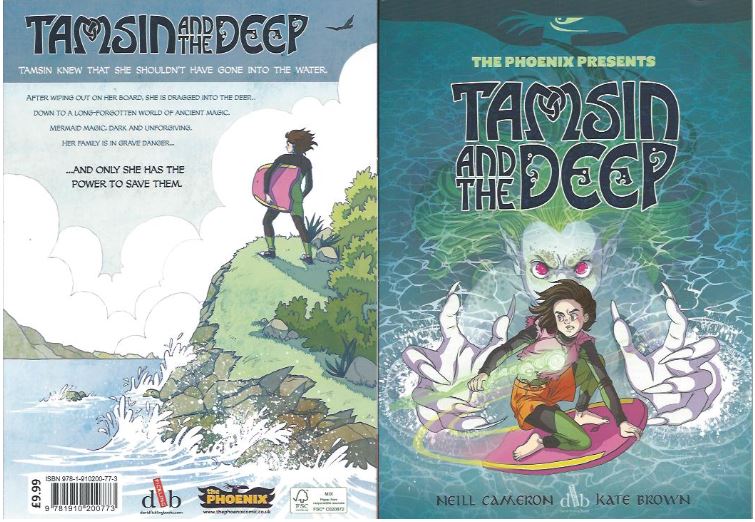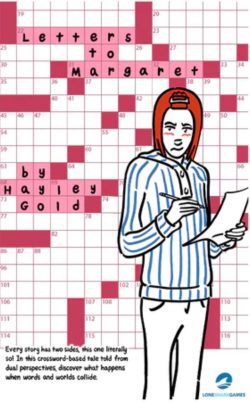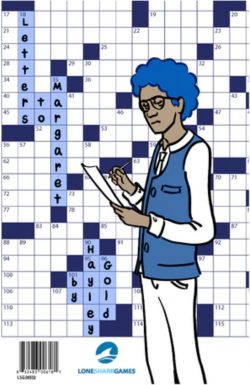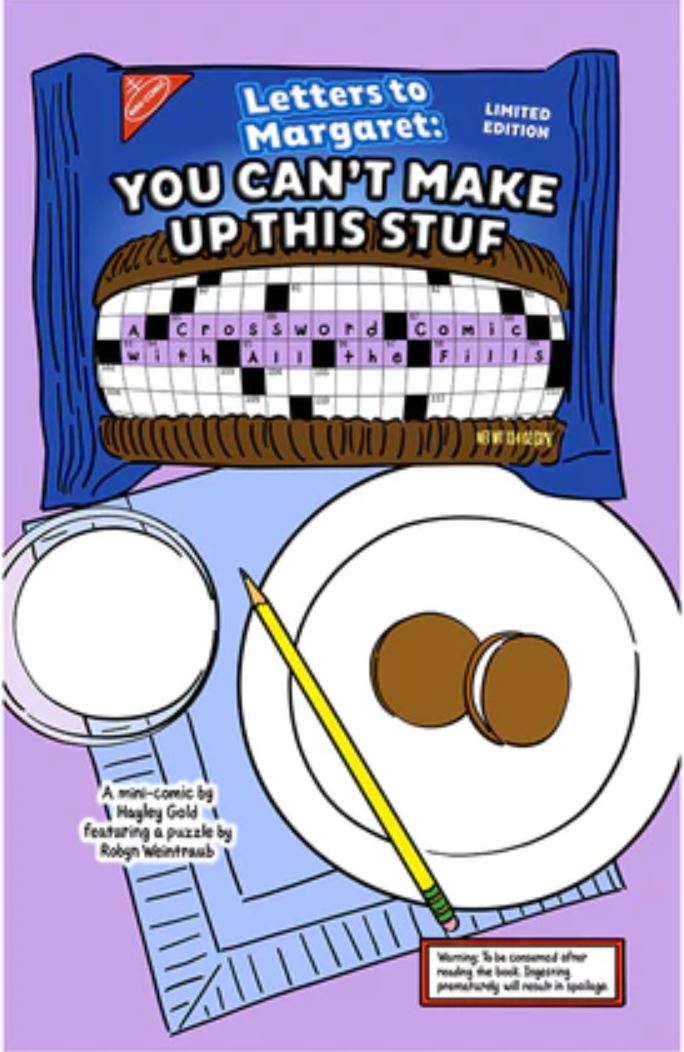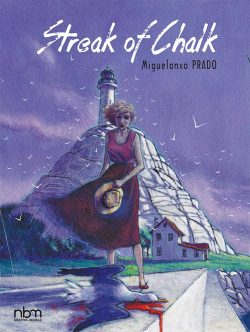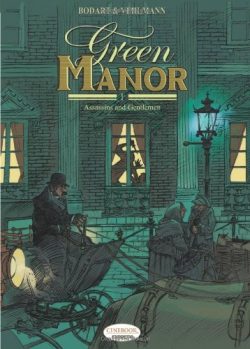
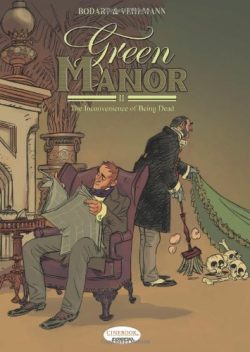
By Bodart & Vehlmann, translated by Elaine Kemp and Luke Spear (Cinebook Expresso)
ISBN: 978-1-905460-53-3 (vol. 1 Album PB) 978-1-905460-64-9 (vol. 2 Album PB)
Shared preconceptions are a wonderful toy to play with if you are a narrative creator – or reviewer. For instance, the French are generally considered more passionate than us reserved Brits (I wonder if that’s still the case?) and always eager to dole out grandiose appellations and epithets about creators, but at least they’re very seldom wrong in their acclamations.
Here’s a little Continental whimsy exploring the notion…
Fabien Vehlmann was only born in 1972 yet his prodigious canon of work (published from 1998 to the present) has earned him the soubriquet of “the Goscinny of the 21st Centuryâ€â€¦
Vehlmann entered the world in Mont-de-Marsan and grew up in Savoie, studying business management before taking a job with a theatre group. In 1996, after entering a writing contest in Le Journal de Spirou, he caught the comics bug and two years later published – with illustrative collaborator Denis Bodart – a quirky, mordantly dark and gleefully sophisticated portmanteau period crime comedy entitled Green Manor.
The episodic, blackly funny tribute to the seamy underside of Victoriana appeared only sporadically until 2005 (and was revived in 2011), whilst the author spread his wings with a swathe of other features such as Wondertown (art by Benoît Feroumont) and the hugely popular children’s thriller Seuls (with artist Bruno Gazzotti and translated after far too long as the Alone series) before undertaking a high-profile stint on veteran all-ages adventure strip Spirou and Fantasio.
Vehlmann has continued to craft enticing and engaging tales for kids (Samedi et Dimanche) but is equally adept on more mature fare like IAN and Sept psychopaths (with Sean Phillips). He even briefly drew his own strip Bob le Cowboy…
His partner in crime on Green Manor was Denis Bodart, who studied at the Saint Luc academy in Brussels before taking up teaching. He soon resorted to a life in comics, debuting in 1985 with Saint-Germaine des Morts (scripted by Streng) for publishing house Bédéscope.
Three years later he co-created – with writer Yann (Yannick Le Pennetier) – Célestin Speculoos for Circus and Nicotine Goudron for l’Écho des Savanes, whilst acting as a jobbing freelance comics artist with work regularly appearing in Le Journal de Spirou and elsewhere.
Following his highly acclaimed turn here (beginning with Assassins et gentleman), he moved on to succeed Jean-Maire Beuriot as artist of Casterman’s prestigious Amours Fragiles.
The premise of the mystery story is both deliciously simple and wickedly palatable. As this book opens in the infamous Bethlehem Psychiatric Hospital in 1899, eminent Dr. Thorne is attempting to interview the inmate known as Thomas Below.
A domestic in a Gentleman’s Club for his entire life, the poor unfortunate became violently delusional mere days before retirement. Now as Thorne questions the madman deep in the bowels of “Bedlamâ€, the savant realises the sorry soul before him believes he is Green Manor incarnate. He has certainly been privy to all that strange place’s secrets, surprises and hushed-up scandals. Hesitantly at first, Below begins telling tales of rich, powerful and ostensibly honourable men at their most excessive and unbearable…
What follows is a macabre menu of short tales linked by proximity and tone, beginning with ‘Delicious Shivers’, wherein a roomful of The Great and the Good gathered around aged patriarch Dr. Byron on an October night in 1879. The respected physician posed an intriguing challenge to the assemblage: “can there be a murder without a victim or a murderer?â€
Most of the men present had dark hearts and cunning minds and Sir Foswell rose to the challenge with his story of a noted aristocrat who erased an unwise early marriage and “disappeared†his unwanted bride by dint of bloodshed, money and influence.
Inspector Darcroft then related a case whereby there was no discernible murderer although the victim was most certainly gunned down at close range…
As the heated banter built, events took a very dark turn once Byron informed them that he had personally caused such an impossible crime to be committed. To the shocked silence of the throng he described how the administration of an extremely slow-acting poison in the drinks of some, many or all of those gathered might or might not kill an unspecified number of them at some unguessable time in the future…
Of course he might just have been jesting to win a point, but nobody went home complacently that night…
‘Post-Scriptum’ described the lethal intellectual duel between dashing young Detective Johnson and aged Sir Alfred Montgomery in August 1882, after the latter defied the policeman to stop him killing a young woman. The rules of the competition are quite strict and the noble believes he has succeeded in committing a perfect crime, but although the noble correctly considers himself a cunning planner his character judgement leaves much to be desired…
Weary and frustrated police Inspector Gray‘s decades-long hunt for a serial killer ended in shock and castigation when he arrived at an astounding conclusion one gloomy night at the Club in September 1882. That worthy’s too-late grasp of an impossible ‘Modus Operandi’ subsequently led to glorious triumph, but also a most surprising outcome and response from a fellow clubman and confidante…
The most baroque and arcane yarn involves another intellectual game and imaginative wager placed in March 1893, when two connoisseurs of crime determined to commit the most artful murder of all time. Their target would be none other than author and criminologist Sir Arthur Conan Doyle, and to make things interesting the offending weapon could only be ’21 Halberds’…
In April 1872 Lord Denton invited young artist Eric Kaye into the Green Manor Club to repair a damaged painting by the great lost genius Jason Sutter. However, the dazzled dauber became obsessed with the story behind the austere family portrait – especially a tragic, beautiful daughter who suddenly vanished from history – depicted in ‘Sutter 1801’, and his fervent enquiries led to the resolution of a decades-old mystery, murder most foul and eventual banishment as his only reward.
Proud and undaunted, Kaye patiently devised a most exquisite vengeance…
The catalogue of upper class skulduggery concludes with ‘The Ballad of Dr. Thompson’ and a most arcane and uncanny murder mystery which begins in 1878, as great friends Professor Ballard and Thompson bid each other a drunken goodnight on the club steps. Only one of them makes it home safely…
When the other’s corpse is found stuffed into a grandfather clock police investigations soon lead to the most insane of conclusions…
Wry, witty, wickedly funny and sublimely entertaining, Assassins and Gentlemen offers a superbly rewarding peek at High Society and low morals as seen from across the Channel and over eventful decades, which will delight and astound lovers of clever crime fiction and classy comics confabulations – and there’s even better to follow…
Sequel release The Inconvenience of Being Dead is a double-length compact Cinebook edition, and like its predecessor is sadly unavailable in English digital formats. However, it does deliver the final pair of original volumes – De l’inconvénient d’être mort and Fantaisies meurtrières – which saw Green Manor’s continual catalogue of High Society crime, calumny, depravity and outrage lead to an inevitable sorry conclusion…
The premise is deliciously simple and wickedly palatable. As seen in the first collection, prominent alienist Dr. Thorne has become obsessed with Thomas Below, currently incarcerated in the infamous Bethlehem Psychiatric Hospital.
Thorne resumes the unconventional interviews in 1899 as the savant is dragged from his bed to attend Below once again. This time the need is most urgent. The old retainer has escaped, broken into a house and taken a family hostage. Hesitantly the healer makes his approach and engages the affable maniac in conversation. All too readily Below begins telling more tales of rich, powerful and ostensibly honourable men at their most excessive and unbearable…
The macabre menu of skits and sketches opens with ‘Child’s Play’ from March 1871 wherein cruel Lord Virgil observed and was incensed by a passive, gentle servant with the patience of Job. The noble’s instantly resolved instinct was to turn the saint into a murdering thing of evil.
Admitting to possession of a foolproof, infallible and much-proved method of killing-by-proxy to a roomful of The Great and the Good gathered around, Virgil determined to drive good-natured George into eternally debasing and damning himself by using the system to save himself from torment. Sadly, one man’s torment is another man’s test of faith, and good old George is far from the predictable peasant he appears…
In 1885, dilettante supernaturalist Joseph Sharp returned from Prague following a fruitless shopping trip for magical spells and objects, only to find his best friend Mark Abbott languishing under the force of a family curse. However, detailed investigation of ‘The Mark of the Beast’ and a ghastly family secret in a crypt only proved once again that the unknown has very little force or impact when measured against a mother’s hate, the infinite patience of the tormented and a victim’s fevered imagination…
One night in 1876, Lord Justice Sherman realised he had condemned an innocent man to death, even though not a single shred of evidence existed to confirm his opinion. With one night remaining to save his man, the elderly jurist took to the streets of London to find the true culprit and succeeded, utterly unaware that the malefactor involved had already taken vengeance for the judge’s noble act in advance of its completion and Sherman’s ‘Last Wishes’…
In 1897 bombastic, belligerent General Miller gloated at the Club. He had at last come into possession of the fabled Spear of Longinus. The military martinet had no fear of the legends and many deaths laid upon the artefact or ‘The Centurion’s Shadow’, but was beguiled by its repute as a tool to make great men all-conquering.
Nevertheless, he was soon one more corpse attributed to the talisman – and not the last – until a pair of the Club’s armchair investigators applied learning and logic: exposing a deadly trap constructed by one of history’s greatest thinkers…albeit, just a little too late…
With the hostage crisis coming to end, Below shares his most shocking epigram as ‘Voodoo Night’ finds the gathered gentlemen – over cigars and brandy – casually dissecting a juicy murder one evening in December 1870. With irreconcilable facts and impossible assumptions heatedly flying about, soon only absurdity or the supernatural are left as answers to the mystery of the slaying of boorish lout Lord Killian. However, in another room, the genteel conversation of the closeted Ladies married to the assemblage of tobacco-smoking idiots soon reveals a so-simple truth…
The last legends of the Club were gathered up in appendix Murderous Fancies, with the increasingly obsessed Thorne receiving word that Below has passed away. Briefly thinking himself free at last, it is with mixed feeling that the doctor takes custody of the illegible scrawls of the troubled retainer and wearily, warily dares to decipher them…
‘Endgame’ relates an incident from June 1871 when the Club was driven to distraction by the will of recently paralysed Lord Wyatt. It was in the form of a nonsense riddle, and the first to solve it would win all Wyatt’s prodigious wealth…
At the same time, the executor secretly consulted with pioneering dementia expert Dr. Sheffer over the mental state of his master. The aristocrat claimed his parlous condition was the result of a murder attempt, and this riddle might well be a trap to catch the assailant. Sheffer knew better but soon had every reason to regret his rather rash conclusions…
‘A Small Crime Serenade’ found an aged, innocuous gentleman in garrulous mood one night in 1867, sharing with a dutiful Club servant his great gift and passion: a life-long ability to get away with murder. Sadly, his boast of capping his career with one final killing was derailed by a most unanticipated event.
In 1827, talk at Green Manor was of only one matter: the recent demise of a radical libertarian poet. Especially fervent was young devotee Dr. Daniel Ballantyne who promptly fell for a cruel prank when the Club grandees purportedly offered him a chance to autopsy the body and look ‘In the Head of William Blake’. They had arranged that what he saw would be like nothing he had ever experienced…
Ballantyne disappeared that night, and in the cold light of day an inexorable campaign of terror began as the japesters were slowly driven mad by notes threatening vengeance from the “Tygers of Wrathâ€â€¦
In lighter vein, ‘Fight to the Finish’ related how a brace of bored big game hunters invented an imaginative game in May 1859. Their aim was to determine who exactly was the absolute best. The prey was to be each other but – although the rules of the competition were strict and fair – as the days progressed it seemed that neither Lord Bennett nor Lord Turner were as able or as gentlemanly as they claimed…
The dead man’s tales ended with a chilling homily from 1872 wherein the cream of Society discussed the strange case of Lord Sanders who had blighted his own financial empire and destroyed his greedy heirs by cruelly and carefully tying the purse-strings of their inheritances.
The dominating oligarch had left a vast list of tasks for his four children to fulfil in ‘The Testament’: far too many for any person or persons to complete before getting their undeserving hands on his ill-gotten gains. Of course, even he could not predict how and where greed and frustration could take a desperate man…
And with that final story shared, Below no longer plagued the good doctor’s days, but his influence remained long after he was gone…
Mordant, imaginative, darkly wry and cruelly rewarding, The Inconvenience of Being Dead confirms our most heartfelt suspicions about the pointlessly privileged and inexplicably esteemed, damning them all as useless, venal and worse: A class apart that we could all do without, but a perfect target for all the disdain we can wring from them with rich black comedy and classy comics confabulations like these.
Original editions © Dupuis 2005 by Vehlmann & Bodart. All rights reserved. English translations 2008 by Cinebook Ltd.
